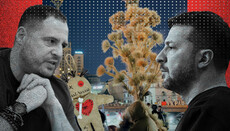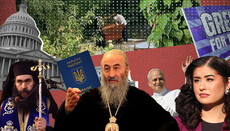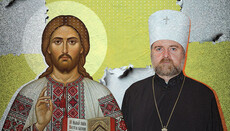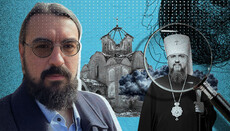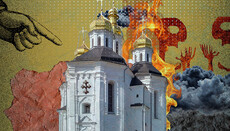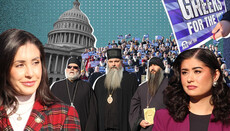Funny sociology or Why despite growing support for OCU there’s none to pray

Opinion polls prove that most Ukrainians affiliate with the OCU. But its churches are empty, there're no processions. Which to believe: sociologists or your eyes?
Recent opinion polls show an increase in support for the OCU in Ukrainian society. However, the real, not statistical reality, demonstrates the opposite: there are very few worshipers in the churches of the OCU, there are practically no monks in the monasteries, and the “bishops” complain that no one wants to become OCU “priests”. Why is this happening, and what do the poll results really mean? Let's try to figure it out.
The private company Kyiv International Institute of Sociology (KIIS) published a sociological study, according to which 58% of Ukrainian citizens (with the exception of the Crimea and the uncontrolled part of the Donbass) allegedly identify themselves with the Orthodox Church of Ukraine (OCU). Moreover, the growth of this identification in comparison with last year, according to the representatives of this sociological office, amounts to as much as 10.3%.

At the same time, according to the poll, 25.4% of Ukrainians “identify” themselves with the Ukrainian Orthodox Church. 12% call themselves a kind of "abstract Orthodox" without any relation to any jurisdiction.
This poll caused a storm of jubilation in the camp of the OCU and related media resources. Speaking about the related resources, we mean not only Ukrainian ones. For example, the BBC wrote about this, as well as the openly pro-Phanar English-language resource “Orthodox Times". The activity of “patriots” and Phanariotes is understandable because sociology seems to prove that most Ukrainians specifically call themselves members of the OCU. This means that this religious structure has been established, the Patriarchate of Constantinople did everything right in 2018, and Vladimir Zelensky did everything right by inviting the Phanar head to Ukraine to celebrate Independence Day. But if you take a deeper look, everything looks a little different.
There are more "OCU-identified" but fewer parishes
To understand the sociological research of the KIIS, let's translate the percentage of opinion polls into absolute figures. Of course, this extrapolation is very conditional, but, nevertheless, it makes it possible to see what is behind the dry figures of opinion polls. So, if we assume that the population of Ukraine is 41.5 million people (the estimated data of the State Statistics Committee of Ukraine as of 01.01.2021), then 24.2 million people identify themselves as the OCU, and those who identify themselves as the UOC – 10.5 million. That is, there are 2.3 times more members of the OCU than the UOC. Elementary logic dictates that the number of parishes should be approximately in the same proportion: OCU parishes should be at least twice as many as that of the UOC. After all, if a person identifies themselves with a particular denomination, it is logical to assume that they go to church.
According to sociology, each OCU community should have an average of 3.4 thousand people.
Meanwhile, the real, not sociological reality is the exact opposite: the UOC has 12,410 parishes, the OCU – 7,097 (as of 01.01.2020, the latest official data of the Ministry of Culture). That is, there are almost twice as many parishes of the UOC. In terms of one parish, each OCU community should have an average of 3.4 thousand people, and each UOC community – 846. Like anything average, these calculations are very relative, but they perfectly demonstrate that the figure of 846 people in the community is more or less realistic (at least for city parishes), while 3400 people per parish are absolutely unrealistic.
Suppose that we believed the figures of the sociology cited, then we should see the churches of the OCU simply burst from a huge number of worshipers, crowds of people who cannot fit inside stand around the churches. But in reality, we observe the opposite picture: OCU churches are practically empty while UOC churches are crowded with people. To prove a point, we will give a couple of recent examples, namely, photographs taken at the same time in the Khmelnytsky and Odessa Eparchies of the UOC and OCU.
Here is a photo from the all-night vigil on the eve of the feast of the Holy Apostles Peter and Paul in the Cathedral of the OCU in Khmelnytsky on July 11, 2021.

This is neither a photoshop, nor a collage, nor the intrigues of "propagandists", this photo was published by Pavel Yuristy himself, and it is difficult to notice the parishioners in it at all. And here is a photo from the Cathedral of the UOC:

As you can see, a whole line of believers is waiting for the bishop, and this is a close-up, and it simply did not capture the entire number of parishioners that day.
A similar situation is in another region of Ukraine – Odessa. Here is a photograph of the "divine service" on the eve of the feast of Peter and Paul in the Odessa Cathedral of the OCU. In it, like in Khmelnytsky, you will not see parishioners at all, and this is at the "service" of the great feast!

And here is a photo of the service from the Odessa Cathedral of the UOC. Most of the photo is taken by the pulpit, and not the main part of the temple, where the parishioners are standing. But even the number of people captured by the photographer's lens is enough to make an unambiguous conclusion - there are "somewhat more" of them than in the church of the OCU.

Examples from other regions can also be cited, but the overwhelming majority of the picture will be identical – in the churches of the UOC and OCU, the situation in terms of the number of people is not at all in favour of the latter.
Where are cross processions?
One of the surprising (or not surprising) features of the OCU as a religious organization is the almost complete absence of cross processions. The only event in the year when this structure (and before it – the UOC-KP) organized something similar to a religious procession was the Day of the Baptism of Rus’. In the past 2020, religious processions were not held due to quarantine, and in 2019, on the day of remembrance of Saint Prince Vladimir, the OCU was able to gather, according to the Ministry of Internal Affairs, about 15 thousand people, and judging by the photo and video documents – no more than 10 thousand. But this was the first "historic" religious procession of the OCU, in which, in theory, the maximum number of people should have participated.
One of the surprising (or not surprising) features of the OCU as a religious organization is the almost complete absence of cross processions.

In the same 2019, about 300 thousand people took part in the Great Procession of the UOC, i.e. about 30 (!) times more.

These figures do not at all correlate with the data of opinion polls, because according to them, there are 2 times more supporters of the OCU in Ukrainian society, and not 30 times fewer. But the problem is that these conditional 10,000 that the OCU gathered in Kyiv on the Day of Baptism in 2019 is just a "one-time action". Since then, neither in Kyiv nor in the regions, the OCU has failed to organize any numerous events, be it prayers or cross processions. While in the UOC only in July 2021, several thousand annual religious processions took place at once: in the Mukachevo Eparchy to the Domboki Monastery, in the Rivne Eparchy – the Rivne – Onishkovtsi procession, in the Chernivtsi-Bukovyna Eparchy – the Chernivtsi-Kreschatytsky Monastery procession, in the Odessa Eparchy – to the Holy Protection Skete of the Assumption Monastery, in Kyiv – to the Robe Deposition Monastery in Tomashivka and others.

There is nothing like this in any eparchy of the OCU. A question arises: if there are many millions of believers in the OCU, why are they not at religious processions, prayers, solemn services, etc. Why do they not manifest themselves in the forms of religiosity traditional for our people?
If there are many millions of believers in the OCU, why are they not at religious processions, prayers, solemn services?
Shortage of "priesthood" and "monasticism"
The same official statistics of the Ministry of Culture says that for 7,097 OCU communities there are only 4,537 “clerics” or about 0.6 “priests” per parish, and if we exclude “bishops” and “deacons”, then even fewer. This situation may indicate that many OCU communities exist only on paper, but in reality, they do not hold regular services or do not function at all.
At the same time, there are even more priests in the UOC than parishes – 12, 456. And this is a completely normal situation. Parishes really exist, regular services are held in them, pastoral care of the faithful is really taking place.
The OCU is trying to solve the catastrophic shortage of "priests" by any means, attracting almost everyone into the "clergy". You even don't need to have relevant education for this. Back in 2019, “Metropolitan” Daniil Kovalchuk of the OCU, in despair wrote on “The Bukovyna Orthodox” Facebook page: “We implore you – search in the villages for men who are worthy to serve the Lord God in the Holy Church. The men who can bear the brunt of the priesthood – bear for the sake of the future of your children, our Church and state. We will help you get the knowledge you need to serve God and people in the Church." Since then, little has changed.
In terms of the number of "monastics", the OCU looks so miserable that in recent years it has not even submitted the relevant statistics, so as not to be disgraced once again. According to the latest data, in 2019 the OCU had 77 monasteries and 248 “monastics”. By a simple arithmetic operation, we get an average of 3.2 "monks" per monastery. At the same time, if you have a closer look at the statistics for eparchies, you will notice that in many of them the number of “monks” is less than the number of “monasteries”.
In terms of the number of "monastics", the OCU looks so miserable that in recent years it has not even submitted the relevant statistics, so as not to be disgraced once again.
At the same time, according to the latest data in December 2020, there were 255 monasteries and 4,548 monastics in the UOC (17.8 people per monastery on average).
Interesting and indicative is the projection of the number of monastics on the total number of people who consider themselves to be of a particular confession. After all, monasticism is the colour of church life, an indicator of striving for the Heavenly Kingdom. As the patristic tradition says: "The light to the laity is the monks, and the light to the monks is the angels."
So, if you believe the opinion polls of the KIIS, then for 24.2 million people who consider themselves supporters of the OCU, there are only 248 “monastics” or 1 monk for 97.5 thousand believers. While for 10.5 million believers of the UOC there are 4,548 monastics or 1 monk for 2.3 thousand people. And this means that the desire to reject everything worldly and fully devote oneself to God in the UOC is more than 42 (!) times higher than in the OCU.
Is the President's Office involved in the poll?
Of course, when you analyze the church situation, the first thing you come to is that such sociology is primarily beneficial to the OCU, and it is this organization that is most likely the initiator of the survey. However, things are not so simple. On July 14, the Resident Telegram channel reported the following: “Our source in the OP said that preparations are underway at the President's Office for the arrival of Ecumenical Patriarch Bartholomew I, who will become the main guest at the 30th anniversary of Ukraine's Independence. The custom sociology on religious beliefs was paid for by Bankova to create the illusion with the Patriarch of Constantinople that the OCU is the main Church for Ukrainians. The President's Office understands that the arrival of Bartholomew I to Kyiv may cause religious confrontation in the country, but for the functionaries of Bankova, the Ecumenical Patriarch is the main guest at the Crimean Platform."
Certainly, when there is no specific indication of the sources, we cannot be completely sure that the OP is indeed an interested party in the emergence of such a survey. On the other hand, when many people in the media space are perplexed in what capacity Patriarch Bartholomew is going to Ukraine, the authorities' creation of such sociology looks quite justified, although not entirely clean. Well, the fact that the KIIS data are critically at variance with the objective reality is already a secondary issue. After all, not all Ukrainians have such a critical mindset as to ask themselves how credible the figures of such a survey are.
Conclusions
As you can see, the dissonance between the results of opinion polls and reality is enormous. According to the KIIS, in the OCU there are 24.5 million “believers” who do not go to church, do not hold religious processions, do not want to become “priests” and, moreover, “monastics”. What is the reason for this huge difference?
The published results of opinion polls are unreliable and do not reflect the real picture. Any sociologist knows the tricks that can be used to ask a question in such a way or to such respondents to finally get the "desired" result.
The first answer is obvious and fully justified – the published results of opinion polls are unreliable and do not reflect the real picture. Any sociologist knows the tricks that can be used to ask a question in such a way or to such respondents to finally get the "desired" result. That is, the numbers that will please the ordering customers of the poll or those who provide funding to the sociological service. In such cases, the proverb is justified that there are two types of lies: blatant lies and statistics. But this answer seems incomplete and does not fully reflect the real situation in Ukrainian society.
There is a certain percentage of the result “stretching” in favour of the OCU, but the main reason for the aforementioned dissonance is that the KIIS and similar organizations ascribe to the OCU people who determine their attitude to various confessions not by religious, but by their socio-political sympathy. In other words, in the minds of these people, the OCU is associated not with Christ but with Ukraine, the national idea, state-building, etc. Such people can take over a church of the UOC (this corresponds to their national identity), but they are not ready to pray, fast and fulfil the commandments of God. They are ready to identify themselves as the OCU in the face of opinion polls, but they are not ready to go to services, and even more so – to go out with icons and banners to the procession.
They are ready to identify themselves as the OCU in the face of opinion polls, but they are not ready to go to services, and even more so – to go out with icons and banners to the procession.
Yuri Biryukov, a former advisor to the former President of Ukraine P. Poroshenko, described such people and himself very clearly. In 2018, on the eve of the Tomos, he wrote the following on his Facebook page: “I am a real atheist. Absolutely. But an atheist, of course, of the Kyiv Patriarchate. And I watched the Tomos story not because it would somehow affect me but because the whole country needs it.”
Journalist Ayder Muzhdabaev, who has repeatedly denounced the UOC, said the same but in other words: "I am an atheist, but I understand that autocephaly is important for any person in our country."
Here is the answer to the question posed at the beginning of the article – why do so many people identify with the OCU? Not because "it will somehow affect exactly" them, their lives, their religious consciousness, but "because the whole country needs it".
Faith in Christ is not about the country, and not about the national idea. Faith in Christ is about repentance, about the struggle with your sins and passionate aspirations, about prayer and the fulfilment of God's commandments. Faith in Christ is about the acquisition of the Holy Spirit and eternal joy in the Kingdom of Heaven.
